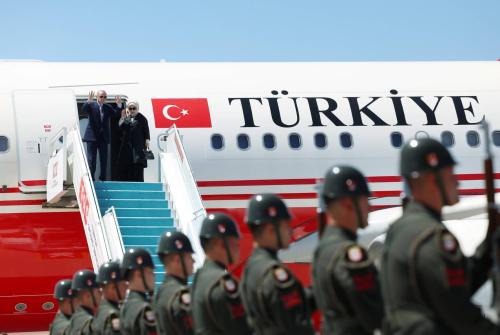Content from the Brookings-Tsinghua Public Policy Center is now archived. Since October 1, 2020, Brookings has maintained a limited partnership with Tsinghua University School of Public Policy and Management that is intended to facilitate jointly organized dialogues, meetings, and/or events.
The ongoing standoff between Chinese and Indian forces at the Doklam Plateau near the tri-junction border with Bhutan bears close watching, but does not yet merit alarm bells.
Over the near term, the standoff likely will continue to fester. Neither side feels pressure to tone down the dispute, and the political calendar in China limits flexibility on matters involving sovereignty and territorial integrity. With time, though, odds favor a peaceful resolution to the standoff. Both sides have accumulated wisdom in dealing with prior standoffs, hold frequent senior-level engagements, and lack a strategic rationale to initiate war over a remote road in the Himalayas.
The United States could use the dispute as an opportunity to clarify privately for both China and India its strategic interest in stable and productive relations between the two Asian powers. Beyond that, the United States should avoid involving itself in the dispute, either privately or publicly, as any such involvement likely will not help to calm tensions, but could have the unintended effect of hardening each side’s position as well as souring U.S. relations with one or both of the disputants.

Warning bells, but no alarms yet
Three primary factors in the dispute bear close monitoring, as they risk causing tensions to escalate if not managed properly:
- Elevated rhetoric. Chinese official spokespeople and authoritative Chinese media have employed increasingly strident rhetoric to demand Indian capitulation. Similarly, official Chinese news outlets have reported on the Chinese People’s Liberation Army (PLA) conducting live fire exercises near the area of the dispute and the PLA’s preparations to “defend” every inch of Chinese sovereignty. By comparison, Indian official statements and updates on troop activities in the disputed area have been more measured. Public pressure by either disputant is not likely to moderate the other’s actions. On the contrary, such statements erode the diplomatic space needed for Chinese and Indian leaders to identify an off-ramp.
- Timing and politics. The PLA spokesperson has linked this standoff to the PLA’s celebration of its 90th anniversary on August 1, thus situating the PLA’s handling of the dispute along a continuum of PLA efforts over the past 90 years to uphold China’s sovereignty and territorial integrity. At a broader level, this is a political year in China, with the 19th Party Congress slated for autumn. The Party Congress is a once-every-five-year event at which the top leadership turns over. The Party Congress is preceded by the annual leadership conclave at Beidaihe in August, a closed-door beachside retreat during which current and former leaders jockey to advance their agendas and promote their favored officials. In such a charged political environment, there is every incentive for Chinese officials to guard against being perceived as “weak.” Similarly, for India, Prime Minister Narendra Modi has limited political space to unilaterally back down, given concern that such a decision could invite further pressure from China in the future, in addition to undermining the credibility of India’s security commitment to Bhutan.
Broader bilateral frictions. The standoff coincides with ongoing tensions between Beijing and New Delhi. Beijing has grown irritated by New Delhi’s withholding of support for China’s “Belt and Road” initiative; its tilt toward Washington, Tokyo, and Canberra; its recent participation in the Malabar military exercise along with American and Japanese navies in the Bay of Bengal; and its ongoing support for the Dalai Lama’s activities. Beijing also views warily New Delhi’s growing activism in Southeast Asia, perceiving New Delhi’s actions as an unwelcome challenge to Beijing’s efforts to cement its leadership of the region. New Delhi is similarly frustrated with Beijing’s obstruction of its membership in the Nuclear Suppliers Group; its opposition to listing Pakistan-based individuals under U.N. terrorist designations; its strengthening of relations with Pakistan, particularly via its construction of the China-Pakistan Economic Corridor, which runs through disputed India-Pakistan territory; and its perceived efforts to encircle India strategically through increased naval activity in the Indian Ocean and its rapidly expanding commercial and diplomatic footprint throughout South and Central Asia.
While these risks are real, nothing yet suggests that Beijing and New Delhi are destined for conflict over Doklam. To the contrary, there remains cause for cautious optimism that both sides will peacefully resolve this dispute, just as they have in numerous previous disputes along the China-India border over recent decades. Factors supporting an eventual peaceful resolution of the conflict include:
- Benefits of experience. As Indian Foreign Secretary Subrahmanyam Jaishankar highlighted in a speech on July 11, China and India have accumulated a strong record since 1962 of peacefully resolving border disputes. Lessons learned from those experiences could be carried over to this latest dispute.
- Active diplomatic channels. In addition to the various existing China-India mechanisms for managing disputes, there are a host of opportunities for high-level engagement through both countries’ membership in overlapping multilateral organizations, such as the Shanghai Cooperation Organization, the G-20, the BRICS, and the annual Russia-India-China foreign ministers meetings. As a consequence, Chinese and Indian senior officials regularly engage each other in multilateral settings throughout the year, even during periods of heightened bilateral tension. For example, President Xi and Prime Minister Modi spoke on the margins of the G-20 when the standoff was in its nascent stages, Indian National Security Advisor Ajit Doval met on July 27 with his Chinese counterpart, State Councilor Yang Jiechi, on the margins of a BRICS meeting in China, and Prime Minister Modi will see President Xi again at the BRICS Summit in China September 3-4. Provided that practiced hands within both governments keep channels open and avoid giving undue deference to actors outside of the diplomatic process who prefer to fuel rather than dampen tensions, such regular interactions between Chinese and Indian officials should mitigate risk of runaway escalation.
- Costs of conflict prohibitive. It is not likely that either side will allow emotion to override interests in their management of the dispute. Both countries are declared nuclear powers. China is India’s largest trading partner, with bilateral trade topping $70 billion per year. China also is one of the fastest growing sources of foreign direct investment into India. China and India view themselves as partners in pushing back against protectionism and promoting open trade. Broadly speaking, the economic and strategic costs of conflict for both sides are prohibitively high—enough to lead both sides to conclude that it is not in their interest to spark a war over the construction of a remote road in the Himalayas.
U.S. should maintain its distance
To date, the U.S. government has maintained an appropriate distance from this dispute, merely acknowledging that the United States is following the issue closely and that it encourages both sides to engage in direct dialogue to reduce tensions. In present circumstances, the United States has little to gain and much to lose by lending any appearance of tilting toward one party over the other in the dispute.
A more proactive public role for the United States also likely would not have any salutary effect in calming tensions. To the contrary, U.S. public pressure could harden positions as both disputants seek to avoid any appearance of bending to outside pressure. To the extent that the United States government needs to respond to press queries about the dispute, all such responses should come only from the State Department and the Pentagon, and not from the White House, in order to reinforce the signal that the United States is not seeking to insert itself, does not seek to politicize the issue, and instead is monitoring the issue through standard means.
While there is no role for the United States publicly, there may be an opportunity privately.
While there is no role for the United States publicly, there may be an opportunity privately. The United States could use the dispute as an opportunity to clarify for China and India how it identifies its interests in this triangular relationship, and to encourage both parties to de-escalate tensions. U.S. officials could use existing diplomatic channels with Beijing and New Delhi to emphasize privately the U.S. strategic interest in maintaining stable and productive relations between China and India, and the U.S. desire to see both sides cool rhetoric to allow for an eventual peaceful resolution to the dispute. To the extent that U.S. officials encounter conspiratorial theories in Beijing or New Delhi of U.S. partisanship in the dispute, they should respond firmly in private that: 1) no American actions precipitated the dispute; 2) the United States has done nothing to seek to profit from the standoff; 3) Washington does not seek to play any role in the dispute; and 4) the sole focus of U.S. policy is to urge both parties to exercise restraint until such time as they are able to agree upon a peaceful resolution.
Beyond that, the United States should not be prescriptive about the ultimate resolution of the dispute or steps that either side should take, as those choices belong to the parties involved. It also should reject any request to play a mediator role. Any U.S. effort to push either China or India to reduce tensions likely would feed suspicion that the United States is carrying water for the other party in the dispute and is pinning disproportionate responsibility on them to solve the dispute.
What to watch for
There are two important signposts on the horizon.
The first is whether President Xi speaks directly to the standoff in his anticipated public remarks on the occasion of the PLA’s 90th anniversary on August 1. If Xi echoes the strident comments of Chinese officials that have commented to date on the matter, there likely would be a further constricting of political space for any Chinese official to show flexibility in dealing with the dispute for the foreseeable future.
The second signpost will be whether both sides are able to reach a shared understanding on basic principles for managing the dispute ahead of the BRICS Summit that President Xi and Prime Minister Modi are scheduled to attend September 3-4 in China. Elements of such an understanding could include mutual agreement that: neither party will take steps that would elevate tensions without prior bilateral consultations; both sides affirm their commitment to peacefully resolving the dispute; both sides agree to manage the dispute at Doklam as a discrete border-related dispute and not to inflate the issue into a broader strategic competition; and official representatives on both sides will avoid using historical analogies or strategic parallels when commenting publicly on the dispute. Chinese and Indian acceptance of any or all of these principles would put a floor underneath the dispute and push management of the standoff into the hands of capable diplomats on both sides.
Although the timing and final contours for resolving the dispute remain as yet unknowable, there is cause for cautious optimism that the disputants have the wisdom to peacefully resolve the dispute. Chinese and Indian leaders are among the most talented and creative diplomats in the world. Beijing and New Delhi would benefit by focusing their energies now on creating a conducive environment for peaceful solutions to emerge.
The Brookings Institution is committed to quality, independence, and impact.
We are supported by a diverse array of funders. In line with our values and policies, each Brookings publication represents the sole views of its author(s).





Commentary
Navigating the current China-India standoff in Bhutan
July 28, 2017